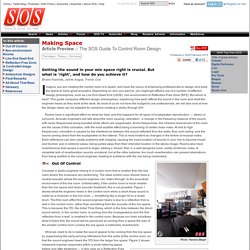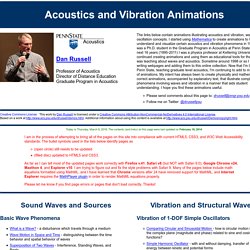

From Analog to Digital – Part 1: Introduction. In this series: This blog post is the first in a series presenting an overview of the theories and practices involved in the conversion of analog signals into their digital counterparts.

This is called analog-to-digital conversion or ADC. ADC is normally used in the front ends of systems that digitally process and/or analyze analog signals. Even though the basic principles of ADC can be relatively simple to grasp, their correct implementation can require special techniques, and a proper understanding of the characteristics and limitations of ADC is important to optimize their usage.
The purpose of this series of blogs is to: Introduce the concepts of sampling and digitizing for those who are unfamiliar with themPresent the different techniques for preparing signals prior to analog-to-digital conversionPresent an overview of ADCs and their characteristicsDiscuss ADC's specifications and inherent limitations. Making Space. Getting the sound in your mix space right is crucial.

But what is ‘right’, and how do you achieve it? Bruno Fazenda, Jamie Angus, Trevor Cox Imagine you are creating the control room of a studio, and have the luxury of employing professionals to design and build the space to have great acoustics. Depending on who you went to, you might get offered one of a number of different design philosophies, such as Live End Dead End (LEDE), non-environment or Reflection-Free Zone (RFZ).
But which is best? Rooms have a significant effect on what we hear, and this happens for all types of loudspeaker reproduction — stereo or surround. Photo: Hannes Bieger Out Of Control Consider a studio engineer mixing in a control room that is smaller than the live room where the musicians are performing. Figure 1: The impulse response heard by the sound engineer in the control room, when a short sharp impulsive sound is made in a larger live space. Non-environment Rooms. Acoustic Treatment Principles - Warp Academy. Simple Ways To Test Your Room’s Frequency Response. We all know that your listening environment has a big impact on the quality of your mix descisions.

Perhaps you’ve already hung some acoustic panels, (maybe you’ve installed a bass trap or two) but how do you know how effective they are? Well, there are many ways to measure your rooms response but I found some helpful audio test files that will give you a pretty good rough idea as to what’s happening in your room. Check ‘em out! (Links to the original website at the bottom) Contents: A sine wave sweeping from 40Hz to 300Hz.Use this to test for: Bass response, sympathetic vibrations. Unless you’re outdoors, or listening on headphones, you’ll notice the volume rising and falling as the audio plays. Use this test as a rough gauge of how extreme the acoustic issues are in your space. Additionally, the sweep can expose low-frequency dependent rattles, buzzes, or other sympathetic vibrations happening in the area around you. Two octave walk-up.
RMAudioFest's channel. Digital loudspeakers - Part 1. HyperPhysics. Indiana edu. About the Author Jeffrey Hass, Associate Professor; Director of the Center for Electronic and Computer Music.

D.M., Indiana University, 1989. Recent compositions premiered by the Louisville Orchestra and Concordia Chamber Orchestra. Performances at Lincoln Center, national conferences of the Society of Composers, Inc., the College Music Society, the International Computer Music Conference and the Society for Electro-acoustic Music in the U.S. Lenard Audio. Page 1 of 1 Sound is vibrating air, which our ears can hear The number of vibrations per second is described as (cps) ‘cycles per second’ (cps) is changed to Hz in honour of the physicist Heinrich Hertz.

Sound frequency measurement is 20 Hz – 20k Hz (20 – 20,000 Hz) Human hearing is approx 30 Hz – 16k Hz and most sensitive between 2k – 3k Hz The lowest note on a double bass or bass guitar is open E (42Hz) The highest notes depending on the instrument is approx 2k Hz Above these highest notes are the harmonics. Notation is based on 12 notes, between each doubling of the frequency (octave) Between (A 110 Hz – A 220 Hz) are 12 notes Between (A 220 Hz – A 440 Hz) are 12 notes and so on. UNSW Acoustics. Introduction to Sound Recording.
Acoustics and Vibration Animations. Today is Thursday, March 8, 2018.

The contents (and links) on this page were last updated on February 18, 2014. I am in the process of attempting to bring all of the pages on this site into compliance with current HTML5, CSS3, and W3C Web Accessibility standards. The bullet symbols used in the lists below identify pages as (open circle) still needs to be updated (filled disc) updated to HTML5 and CSS3. As far as I can tell most of the updated pages work correctly with Firefox v.41, Safari v8 (but NOT with Safari 9.0), Google Chrome v24, Maxthon 4, and Explorer v10. Please let me know if you find page errors or pages that don't load correctly. Acoustical FAQ/Tutorials. Salford Acoustics. SAE. Sengpelaudio. RT60 Acoustic Reverb Calculator. JISC Digital Media Guides. The Ear. Prism - Webinars.